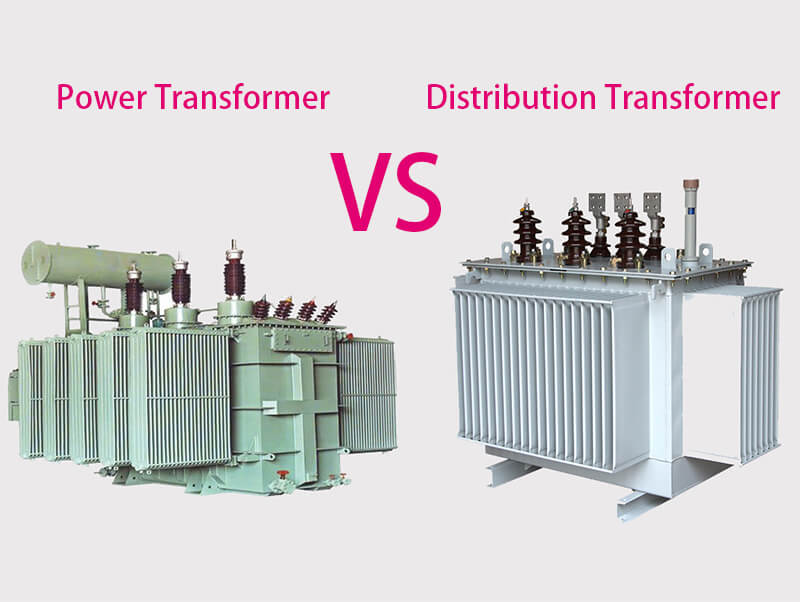Difference Between Power Transformer and Distribution Transformer
Many people are confused about the differences of power transformer and distribution transformer. In fact, there are many differences between them, and this article will help you fully understand their differences.

Power transformer is an electrostatic device used to convert a given value of alternating voltage (current) into another or more voltages (currents) of the same frequency.
Power transformer is one of the main equipment of power plant and substation. The role of the transformer is multifaceted, not only can increase the voltage and transfer the electrical energy to the power consumption area, but also can reduce the voltage to the voltage used by the various levels to meet the power demand. In short, both the boost and the buck must be done by the transformer. In the process of electric energy transmission in the power system, voltage and power are inevitably lost. When the same power is supplied, the voltage loss is inversely proportional to the voltage, and the power loss is inversely proportional to the square of the voltage. Transformers are used to increase voltage and reduce transmission losses.
Power transformers are classified by windings: double windings (each phase is mounted on the same core, and the primary and secondary windings are wound and insulated from each other); Three windings (each phase has three windings, the primary and secondary windings are respectively wound and insulated from each other); Autotransformer (a set of windings with intermediate taps used for primary or secondary output) A three-winding transformer requires that the capacity of the primary winding be greater than or equal to that of the secondary and tertiary windings. The capacity percentage of the three windings is: 100/100/100, 100/50/100, 100/100/50, and the second and third windings are not required to run at full load. In general, the voltage low of the tertiary winding is mainly used for power supply in nearby areas or connected to compensation equipment, and is used to connect three voltage levels.
Distribution transformer refers to a static electric appliance that transmits AC electric energy by changing AC voltage and current according to the law of electromagnetic induction in the distribution system. Some areas will be below 35 kv (most of them are 10KV and below) voltage level of power transformers, called "distribution transformer", referred to as "distribution transformer". The place where the distribution transformer is installed is both a substation. Distribution transformers should be installed on a column or on the ground in the open air. The installation mode, installation precautions, supply mode, capacity selection, operation and maintenance are introduced in detail.
Distribution transformer is a static electrical equipment, its role is used to convert a certain value of ac voltage (current) into another or more voltage (current) with the same frequency. When the primary winding is excited by an alternating current, an alternating flux is generated, and the alternating flux travels through the core, inducing an alternating electromotive force in the secondary winding. The size of the secondary induced electromotive force is related to the number of turns in the primary and secondary windings, that is, the voltage is proportional to the number of turns. The main function is to transmit electric energy, so the rated capacity is its main parameter. Rated capacity is an idiomatic value for power. It represents the amount of electrical energy transferred, expressed in kVA or MVA. It is used to determine the rated current that does not exceed the temperature rise limit under specified conditions when the rated voltage is applied to the transformer. The power transformer with higher energy saving degree is the distribution transformer with amorphous alloy core, and its biggest advantage is the low no-load loss value. Whether to ensure the no-load loss value is the core problem to be considered in the whole design process. In addition to considering that the amorphous alloy core itself is not affected by external force, the characteristic parameters of amorphous alloy must be accurately and reasonably selected in calculation。
Difference between power transformer and distribution transformer
|
|
Power Transformer |
Distribution Transformer |
|
Usage |
Used in Transmission network of higher voltages for step-up and step down application(400kV, 110kV, 66kV, 33kV) and are generally rated above 200MVA. |
Always as step down used for lower voltage distribution networks as a mean to end user connectivity. (33kV, 11kV, 6.6kV. 3.3kV) and are generally rated less than 200MVA. |
|
Size |
heavy and huge in size with a complex design. |
smaller in size & have a simple design which can be easily installed |
|
Full load operation |
Near full load operation (100% full load) |
Operation at 60%-70% full load all day |
|
Efficiency |
High (98-99%) Efficiency = output power(kW)/Input power(kW) |
Low (50-70%) All day Efficiency = output power(kWhr)/Input power(kWhr) in 24 hours |
|
Tap changer |
On-load tap changer Points: 17 points and more Operation: automatic using separate control Media surrounding the taps: oil filled cylinder for arc extinguish placed in parallel to the windings Arc extinguish occurring during tap change: Oil |
Off-load tap changer Points: 3-5 points Operation: Manual after source (voltage) is disconnected from transformerl Media surrounding the taps: transformer oil Arc extinguish occurring during tap change: transformer must be disconnected from any voltage source |
|
Protection |
Buchholz relay Explosion vent pressure relief Temperature indicators Oil level gauges Lighting arrestors Differential protection: overcurrent, overflow, restricted earth fault |
HRC fuse Overcurrent, Buchholz relay and restricted earth fault protection for large transformers larger than 500kV |
If you have related needs of power transformer and distribution transformer, please contact Rockwill for more details.